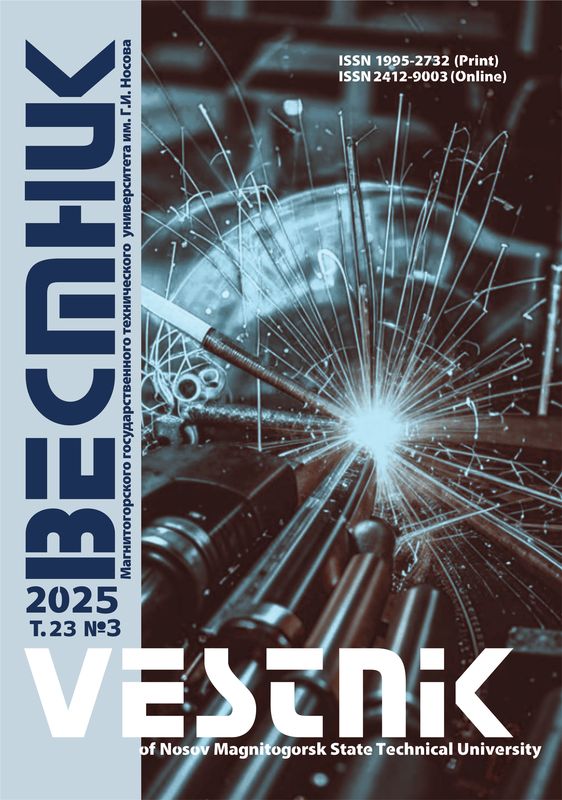DOI: 10.18503/1995-2732-2025-23-1-119-127
Abstract
The effect of homogenization modes on the microstructure and mechanical properties of a strip of high-magnesium aluminum alloy 1590-4 sparingly alloyed with scandium and containing zirconium, hafnium and erbium was studied. For this purpose, the alloy under study was homogenized using single-stage and two-stage modes. After homogenization by both methods, hot and cold rolling followed by annealing were carried out. After completion of annealing, the fine microstructure and mechanical properties of the samples were studied. The structure and phase analysis were studied using transmission electron microscopy. The mechanical properties, namely, the tensile strength and the yield strength, were studied using the uniaxial tension method. The morphology and chemical composition of nanoparticles were studied using transmission microscopy. In addition, scanning microscopy was used for the cast state to study the morphology and chemical composition of large intermetallic particles. It was found that the samples after two-stage homogenization have better mechanical properties than the samples after single-stage homogenizeation due to more abundant precipitation of fine Al3(ScZrHf) particles. In turn, a larger number of particles formed after two-stage homogenization contributes to a more intense interaction of dislocations with them, thereby causing additional strengthening. On the other hand, a larger number of Al3(ScZrHf) particles at the final annealing stage contributes to the inhibition of dislocations and slows down the processes of polygonization and recrystallization, which also leads to an increase in strength properties. Erbium was detected only in the form of large intermetallic particles, which is apparently due to its very low solubility in the aluminum matrix, so it does not participate in the formation of these nanoparticles.
Keywords
aluminum alloys, microalloying, scandium, hafnium, erbium, hot and cold rolling, mechanical properties, microstructure, transmission microscopy, nanoparticles
For citation
Aryshenskiy E.V., Ragazin A.A., Rasposienko D.Yu., Konovalov S.V., Aryshenskiy V.Yu., Lapshov M.A. Study of the Influence of the Homogenization Treatment on the Mechanical Properties and Microstructure of a Sheet of High-Magnesium Aluminum Alloy Doped with Scandium, Zirconium, Hafnium and Erbium. Vestnik Magnitogorskogo Gosudarstvennogo Tekhnicheskogo Universiteta im. G.I. Nosova [Vestnik of Nosov Magnitogorsk State Technical University]. 2025, vol. 23, no. 2, pp. 119-127. https://doi.org/10.18503/1995-2732-2025-23-2-119-127
1. Alattar A.L., Bazhin V.Y. Development properties of aluminum matrix composites reinforced by particles of boron carbide. Journal of Physics: Conference Series. IOP Publishing. 2021;1990(1):012018.
2. Alattar A.L., Nikitina L.N., Bazhin V.Y. Increase in the physicomechanical properties of aluminum alloys reinforced with boron carbide particles. Russian Metallurgy (Metally). 2023;(6): 688-694.
3. Sizyakov V., Bazhin V., Vlasov A. Status and prospects for growth of the aluminum industry. Metallurgist. 2010;(54):409-414.
4. Kozhemyakina A., Pesin A., Pustovoytov D., Nosov L., Baryshnikova A., Lokotunina N., Grachev D Experimental study of the effect of increasing technological plasticity during asymmetric rolling of aluminum alloys. Superplasticity in Advanced Materials: ICSAM. 2023;(32):309.
5. Gupta A. K., Shahare H., Kumar P., Dubey A.K., Pustovoytov D., Yu H., Pesin A., Tandon P. Effect of tool path strategy and tooltip profile on geometrical feature and surface quality of Al-6061 alloy during deformation machining in bending mode. Advances in Materials and Processing Technologies. 2023;(1):297-314.
6. Belov N., Akopyan, T., Tsydenov, K., Sviridova T., Cherkasov, S., Kovalev, A. Effect of Ca addition on structure, phase composition and hardness of Al–6 %Cu–2 %Mn sheet alloy. Journal of Alloys and Compounds. 2024;(1009):176955.
7. Tsydenov K.A., Belov N.A., Doroshenko V.V., Shcherbakova O.O., Muravyeva T.I. Comparative analysis of the effect of magnesium and zinc on the structure and mechanical properties of hot-rolled and cold-rolled alloy Al–2% Cu–1.5% Mn sheets. Metallurgist. 2024;(68):406-417.
8. Ryen Ø, Holmedal B., Nijs O., Nes E., Sjölander E., Ekström H.E. Strengthening mechanisms in solid solution aluminum alloys. Metallurgical and Materials Transactions A. 2006;(6):1999-2006.
9. Elagin V.I. Alloying of deformable aluminum alloys with transition metals [in Russian]. Moscow: Metallurgy, 1975, 247 p.
10. Rana R.S., Purohit R., Das S. Reviews on the influences of alloying elements on the microstructure and mechanical properties of aluminum alloys and aluminum alloy composites. International Journal of Scientific and research publications. 2012;(6):1-7.
11. Reznik P.L. Influence of processing parameters on the structure and mechanical properties of ingots and semi-finished aluminum alloys of Al-Mg-Mn-Sc-Zr and Al-Cu-Mg-Si systems: Ph.D. dissertation. 2017. 192 p.
12. Reiso O., Westengen H., Auran L., Ardal og Sunndal Verk a.s, Sunndalsora, Aluminium. 1980:186-188.
13. Røyset J. Effects of Scandium addition in wrought Aluminium alloys. 2002.
14. Davydov V. G., Elagin V. I., Zakharov V. V., Rostoval D. Alloying aluminum alloys with scandium and zirconium additives. Metal Science and Heat Treatment. 1996;(8):347-352.
15. Hallem H., Lefebvre W., Forbord B., Danoix F., Marthinsen K.The formation of Al3 (ScxZryHf1− x− y)-dispersoids in aluminium alloys. Materials Science and Engineering: A. 1-2006;(2):154-160.
16. Karnesky R. A., Dunand D. C., Seidman D. N. Evolution of nanoscale precipitates in Al microalloyed with Sc and Er. Acta Materialia. 2009;(14):4022-4031.
17. Drits A.M., Aryshensky V.Yu., Aryshensky E.V., Zakharov V.V. Svarivaemiy termicheski ne uprochnyaemiy splav na osnove sistemy Al-Mg [A thermally non-hardenable welded alloy based on the Al-Mg system]. Patent RU, no. 2726520 C1, 2020.
18. Aryshensky E.V., Aryshensky V.Yu., Drits A.M., Grechnikov F. V., Ragozin A.A. Influence of heat treatment modes on mechanical properties of aluminum alloys 1570, 1580 and 1590. Vestnik Samarskogo universiteta. Aerokosmicheskaya tekhnika, tekhnologii i mashinostroenie [Bulletin of Samara University. Aerospace engineering, technology and mechanical engineering], 2022;(4):76-87.(In Russ.)
19. Grant from the Russian Science Foundation № 22-19-00810. Available at: https://rscf.ru/project/22-19-00810/
20. Sokolov S.D., Karakchieva N.I., Abzaev Yu.A., Kakhidze N.I., Zhukov I.A., Sachkov V.I., Vorozhtsov A.B. Structure, phase composition and properties of Al3Er ligature obtained by hydride technology and machining. Vestnik Tomskogo gosudarstvennogo universiteta. Himiya [Tomsk State University Journal of Chemistry], 2024;(34):29-43 (In Russ.)












